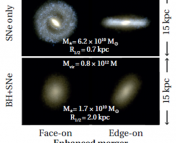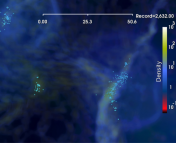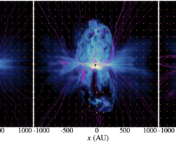Paper Title: Outflows in Star-forming Galaxies: Stacking Analyses of Resolved Winds and the Relation to Their Hosts’ Properties
Authors: G. W. Roberts-Borsani, A. Saintonge, K. L. Masters, and D. V. Stark
First Author’s Institution: Department of Physics and Astronomy, University of California, Los Angeles, 430 Portola Plaza, Los Angeles, CA 90095, USA
Status: Published in MNRAS. Open on arXiv
Galactic Interior
Galactic images captured by spaced based telescopes, such as Hubble, can be breathtaking. Vibrant hues of stellar light infuse with warm gas and dust emission to illuminate the composition of these stunning structures.
However, despite their ethereal nature, some of the Universe’s most extreme interactions occur near their centers. Here, intense feedback – the mechanism by which outflowing matter and radiation impact their environments – rages on.
The two primary modes of galactic feedback are Active Galactic Nuclei (AGN) feedback and supernova feedback. AGN feedback is fueled by the rapid accretion of material onto a supermassive black hole, which is converted into radiation, jets, and winds. Comparatively, supernova feedback results from the explosion of a massive dying star.
These processes are of great interest to researchers because they may regulate their host galaxy’s evolution. For example, outflowing radiation from a compact source can potentially clear out reservoirs of cold molecular gas in its vicinity and restrict local star formation, potentially suppressing the growth of the host galaxy.
Outflows in Star-Forming Galaxies
The authors of today’s paper explored the properties of galactic stellar feedback. They utilized the Mapping Galaxies at Apache Point Observatory (MaNGA) survey to spatially resolve galactic-scale outflows in a sample of 405 high mass (log M✶/M☉ ≥ 10) nearby galaxies (z ~ 0).
The authors elected to exclude AGN from their analysis because the elevated cloud velocities (> 1,000 km/s) in the Broad Line Region, the region closest to the AGN, often mimic the presence of outflows. This certainly eliminates potential contamination; though, AGN feedback is of great interest to astronomers due to the immense power and physical scale associated with AGN outflows.
Figure 1 showcases a typical MaNGA observation conducted with integral field unit spectroscopy.
To conduct their study, the authors traced the radial extent of the galactic outflows by analyzing the spectra of Sodium absorption and emission lines. To help determine the origin of the outflows, they examined star formation rates, star formation rate densities, dust extinction, and the D(4000) index of the galaxies. In addition, they incorporated a stacking technique that bins spaxels (a pixel with a spectral dimension) to construct high signal to noise composite spectra and determine how outflow properties change as a function of galactocentric distance.
Figure 1. An example of IFU MaNGA galaxy property maps. From left to right, top to bottom: The Sloan Digital Sky Survey image of an example galaxy within the MaNGA field of view, the Hα velocity, Hα flux, Hβ flux, the Balmer decrement (Hα/Hβ), and the D(4000) index. (Figure 2 in the paper.)
Outflow Origins
Their findings reveal strong outflows near the cores of the MaNGA galaxies. Moreover, they identify strong similarities between the evolution of mass outflow rates (M☉/yr) and star formation rate densities (M☉/yr/kpc-2), as well as stellar densities (M☉/kpc2) at increasing galactocentric distances (Figure 2). This suggests that elevated star formation activity drives stronger outflows.
Figure 2. The normalized evolution of the mean mass outflow rate compared to several key galaxy properties (i.e., star formation rate density, stellar mass density, dust extinction, and D(4000)), with error bars. The mass outflow rate is most similar to the evolution of star formation density and stellar mass density. (Figure 6 in the paper.)
If outflows are suspected to suppress star formation, why are the strongest outflows found in regions with the highest star formation rates?
Let’s consider a galactic fountain scenario. During this process, a massive star undergoes a brilliant supernova explosion that generates powerful outflows. The energetic streams that emanate from the dying star entrain metal-enriched matter and heat gas several parsecs below or above the plane of the galaxy. The gas eventually cools before falling back down towards the galactic disk, forming the fountain.
The frequency of these events is dependent on the abundance of supernovae, which scales with star formation. The authors’ findings are consistent with this relation. Despite the outflows potentially clearing the cool molecular gas, the star formation density is still found to be the most dominant parameter that scales with the strength of outflows – more stars lead to more supernovae and therefore more outflows.
Furthermore, stellar feedback is generated by more than just supernova activity! Bipolar outflows and stellar winds can also inject energy and momentum into surrounding gas. As star formation increases, the occurrence of these events is likely to increase as well.
The authors also consider a critical “blow out” star formation density that marks the threshold where stellar feedback is strong enough to escape the disk of the galaxy. They equate the weight of the disk gas to the pressure imparted by the feedback and derive a value of ~ 0.02 M☉/yr/kpc-2. Above this value, pressure from the feedback exceeds the weight of the gas for nearby galaxies (z ~ 0) – the outflows are liberated.
Missing Link in Galactic Evolution
Today’s paper offers preliminary evidence that star-forming regions strongly influence the presence of outflows. Stellar feedback is also found to be strongest near the center of the observed MaNGA galaxies.
However, to fully unravel the dynamics of the outflows, a thorough analysis of AGN feedback is essential. AGN outflows tend to be more energetic and may be even more critical for understanding the coevolution between feedback and galactic growth. For example, if star formation is determined to be repressed in the presence of AGN outflows, it may suggest that powerful AGN radiation, jets, and winds completely clear the cold molecular gas in their path. Such a result would counter the positive correlation between outflow strength and star formation density found here with stellar feedback. Future MaNGA studies that incorporate both modes of feedback will help determine the true nature of galactic-scale outflows and how they influence galactic growth.
Nonetheless, today’s paper offers us great insight into the properties of outflows and their relation to stellar feedback!




